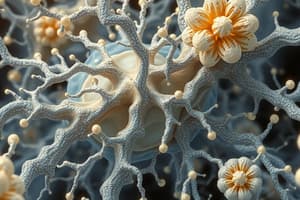Podcast
Questions and Answers
What is the main function of red blood cells?
What is the main function of red blood cells?
- Defense against pathogens
- Transport of oxygen (correct)
- Regulation of blood pressure
- Transport of nutrients
Which of the following correctly defines a tissue?
Which of the following correctly defines a tissue?
- A collection of organelles within a cell
- A single cell performing a specific function
- A group of different organs working together
- A group of cells with similar structures functioning together (correct)
What is the role of mitochondria in sperm cells?
What is the role of mitochondria in sperm cells?
- Photosynthesis
- Nutrient storage
- Protein synthesis
- Energy production (correct)
Which of the following is an example of an organ system?
Which of the following is an example of an organ system?
Which feature is true for egg cells?
Which feature is true for egg cells?
Which organelle is responsible for controlling the activities of both plant and animal cells?
Which organelle is responsible for controlling the activities of both plant and animal cells?
What is the primary function of the chloroplast in plant cells?
What is the primary function of the chloroplast in plant cells?
Which type of cell contains a vacuole that helps maintain shape?
Which type of cell contains a vacuole that helps maintain shape?
What is the role of ribosomes in cells?
What is the role of ribosomes in cells?
Which specialized cell is adapted with long extensions to increase surface area for absorption?
Which specialized cell is adapted with long extensions to increase surface area for absorption?
What distinguishes xylem vessels in their function?
What distinguishes xylem vessels in their function?
What cellular process occurs in mitochondria?
What cellular process occurs in mitochondria?
Which of the following describes a key feature of ciliated cells?
Which of the following describes a key feature of ciliated cells?
Flashcards
Tissue
Tissue
A group of similar cells working together to perform a specific function.
Organ
Organ
A structure made of different tissues working together for a specific function.
Organ System
Organ System
A group of organs working together to carry out major body functions.
Organelle
Organelle
Signup and view all the flashcards
Specialised Cell
Specialised Cell
Signup and view all the flashcards
What is the function of the nucleus?
What is the function of the nucleus?
Signup and view all the flashcards
What is the role of the cytoplasm?
What is the role of the cytoplasm?
Signup and view all the flashcards
What is the function of the chloroplast?
What is the function of the chloroplast?
Signup and view all the flashcards
What does the cell wall do?
What does the cell wall do?
Signup and view all the flashcards
What is the role of the cell membrane?
What is the role of the cell membrane?
Signup and view all the flashcards
What is the function of the vacuole?
What is the function of the vacuole?
Signup and view all the flashcards
What is the role of the rough endoplasmic reticulum?
What is the role of the rough endoplasmic reticulum?
Signup and view all the flashcards
What is the function of ribosomes?
What is the function of ribosomes?
Signup and view all the flashcards
Study Notes
Topic 2: Organisation of the Organism
- Cells: Basic units of life, specialized for specific functions
- Ciliated Cells: Move mucus in the trachea using tiny hairs (cilia)
- Root Hair Cells: Absorb water and ions from the soil, increased surface area for absorption
- Xylem Vessels: Transport water and support plants, no cytoplasm or end walls for efficient water flow
- Palisade Mesophyll: Photosynthesis, tightly packed cells with numerous chloroplasts
- Nerve Cells: Conduct nerve impulses, long axons with branches for rapid signal transmission
- Red Blood Cells: Transport oxygen, no nucleus for more space for oxygen-carrying hemoglobin, biconcave shape
- Sperm Cells: Reproduction, tail for movement, mitochondria for energy, multiple sperm prevention
- Egg Cells: Reproduction, large size, energy stores for development, multiple sperm prevention
Tissues
- Tissues: Groups of similar cells working together, performing a shared function (e.g., muscle tissue, palisade mesophyll)
Organs
- Organs: Structures made of multiple tissues working together to perform specific tasks (e.g., heart, kidney, leaves)
Organ Systems
- Organ Systems: Groups of organs working together for related functions (e.g., digestive system, circulatory system)
Cell Specialization
- Specialized cells exhibit specific adaptations for optimal function in their roles. (e.g., shape, size, and internal structure)
Studying That Suits You
Use AI to generate personalized quizzes and flashcards to suit your learning preferences.
Related Documents
Description
Explore the diverse structures and functions of various cells and tissues in living organisms. This quiz covers specialized cells like nerve, red blood, and plant tissues, detailing their unique roles and characteristics. Test your knowledge on how these components work together to support life.




